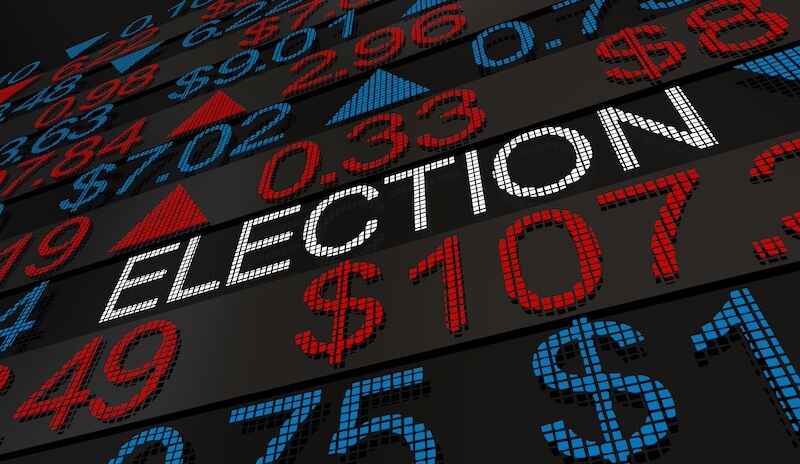The Fed’s rosy outlook is crumbling.
Many economic indicators are flashing yellow – in some cases, crimson red.
And if the Fed’s own model is to be believed…
A downturn may be right around the corner.
There’s a lot of risk to consider, which is why having a backup plan is crucial.
My colleague Marc Lichtenfeld has just uncovered a little-known investment that can help you lock in contractually obligated returns of up to 50% annually.
What will the coming presidential election mean for your portfolio?
That’s fast becoming a hot topic. And as the 2024 election moves into the post-Labor Day stretch, you’ll hear more and more about how one candidate or party will be much better for the stock market than the other. It happens every election cycle without fail.
Former President Donald Trump is already predicting a market crash “like 1929” if Vice President Kamala Harris wins the election. His remarks have been parroted elsewhere.
Others contend that a Trump victory poses the biggest risk of a market crash.
More generally, Democrats claim they’re better for the stock market while Republicans claim the opposite.
But if you look at the market’s performance over the past 80 years, since Harry Truman occupied the Oval Office, you’ll see that it continues to climb – with occasional corrections and bear markets – no matter who is in office.
And the biggest gains are not limited to one party.
The gains of the Clinton era compete with those of the Reagan-Bush era that preceded it. And Obama, Trump, and Biden all put up pretty good numbers.
You can see from the chart above that the market never really goes down for long, though sometimes it remains flat through an administration. But I’m fairly certain that if you dig into what held the market back during these periods it would be difficult to blame the president.
Over the long term, how the market performs is more dependent on the business cycle than political party control.
Of course, some sectors may perform better depending on who wins.
Information technology, consumer discretionary, and financial stocks have tended to get a boost from a Democratic presidential victories. While aterials, real estate, and energy have benefited from Republican wins, at least in the short term.
Bad Ideas
But if campaign-trail promises turn into real-world policies, all sectors will be in trouble in coming years regardless of the election outcome.
That’s because the two candidates have been offering up a plethora of absolutely terrible populist policies. It’s almost as if they’re competing to roll out the worst ideas for the economy and the market.
Harris wants to control the prices that supermarkets can charge via a federal ban on price gouging on groceries. And while it’s not clear how such a ban would work or be enforced, it is clear that this is a truly bad idea. Recall that President Richard Nixon (a Republican!) tried price controls back in 1971, and it went very badly for him.
Even Democratic economists hate it…
“This is not sensible policy, and I think the biggest hope is that it ends up being a lot of rhetoric and no reality,” said Jason Furman, top economic advisor to President Obama.
The vice president also wants to tax unrealized capital gains on stock holdings. Currently, capital gains are only taxed once a stock is sold. Harris’s plan would tax investors whether they’re cashed in or not (though only on the very wealthy).
The potential unintended consequences of such a tax are scary. It could tax paper gains that never actually materialize. It could force investors to sell stocks just to pay taxes, and not for fundamental reasons, which distorts saving and investment decisions. And the tax would definitely discourage smart, long-term investment and entrepreneurship.
For his part, Trump boasts of the massive tariffs he would impose on imports.
There’s good evidence that tariffs on imports reduce domestic GDP, decrease employment, and amount to a tax on U.S. households.
I’m old enough to remember when Republicans believed in the benefits of free trade. Not anymore!
Trump also wants to weaken the dollar. I wrote back in July about how a central economic and trade policy of a second Trump administration would be dollar devaluation.
The goal of such a strategy is to reduce imports and boost exports and thereby reduce the trade deficit. Yet there are major dangers involved with such a policy, the biggest of which is that it could prompt our trade partners to devalue their own currencies – resulting in a currency race to the bottom, as happened in the 1930s to disastrous effect.
All of these policies could hurt our portfolios in major ways. They’re bad for free trade, bad for free markets, bad for corporate profits (and thus for share prices), and ultimately bad for consumers.
But I suppose that when it comes to terrible economic ideas, if your opponent goes low, you go lower.

